The Ultimate Rice Porridge Recipe: A Comforting Lunch for Global Food Lovers
Rice porridge, also known as congee or jook, is a timeless dish cherished across cultures for its simplicity, versatility, and comforting warmth. Whether you’re craving a light lunch, recovering from a long day, or exploring global cuisines, this rice porridge recipe is your go-to solution.
This dish is not only easy to prepare but also highly adaptable to your taste preferences. From savory to sweet, hearty to light, rice porridge can be tailored to suit any palate. In this blog post, we’ll walk you through a foolproof recipe, share expert tips, and explore creative variations to make this dish your own.
So, grab your apron, and let’s dive into the world of rice porridge—a delicious dish that’s as nourishing as it is!
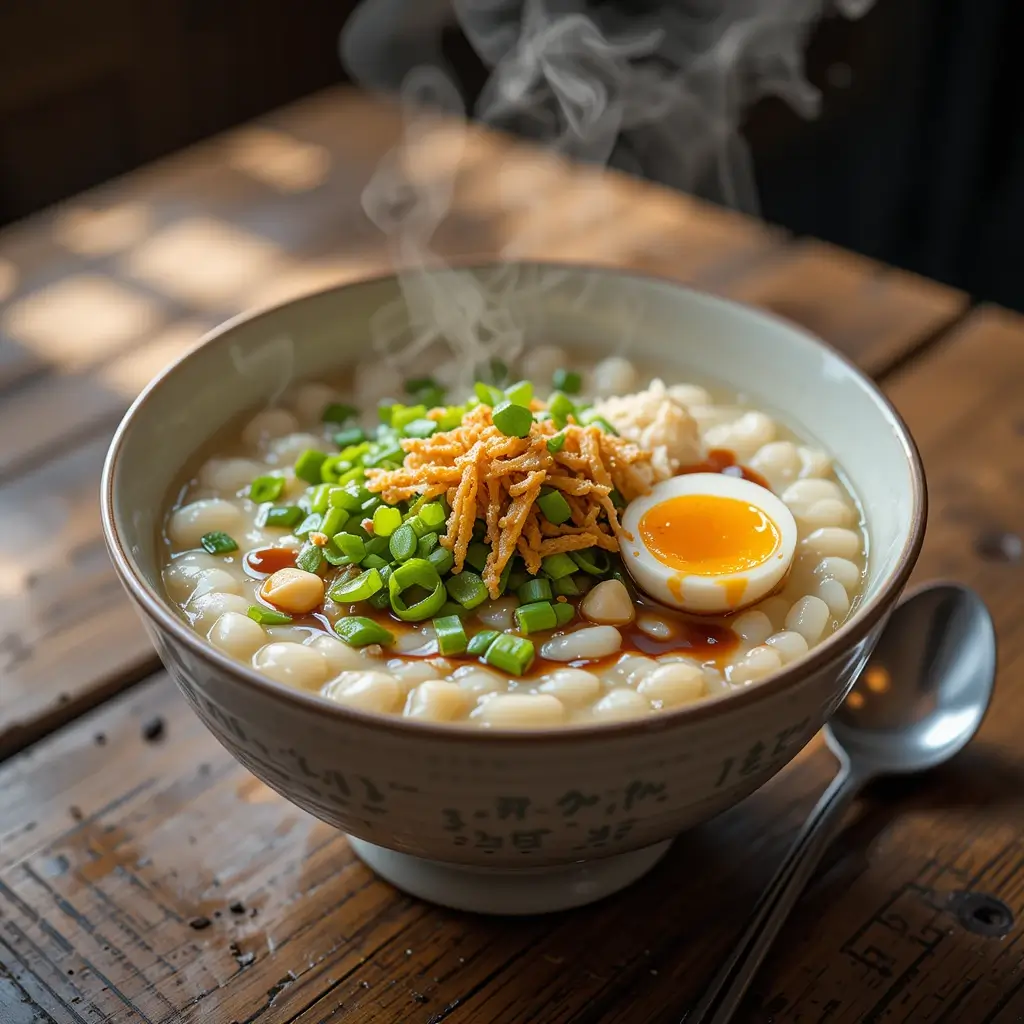
Ingredients for Rice Porridge
Creating a delicious and comforting bowl of rice porridge starts with a handful of simple, wholesome ingredients. Here’s everything you’ll need to make this classic dish:
Base Ingredients
- 1 cup jasmine rice (or any short-grain rice) – Jasmine rice is preferred for its fragrant aroma and creamy texture, but you can also use sushi rice, basmati, or even brown rice for a healthier twist.
- 6 cups water (or broth for extra flavor) – Water works perfectly, but using chicken, vegetable, or bone broth adds a richer, more savory depth to the porridge.
- 1 teaspoon salt (adjust to taste) – Enhances the flavor of the porridge.
- 1 tablespoon neutral oil (e.g., vegetable, avocado, or grapeseed oil) – Helps toast the rice and prevents sticking.
Optional Toppings and Add-Ins
Rice porridge establishes its beauty through multiple uses. Here are some popular toppings and add-ins to customize your bowl:
- Proteins:
- Shredded chicken, pork, or beef
- Soft-boiled or poached eggs
- Tofu or tempeh (for a vegan option)
- Cooked shrimp or fish
- Vegetables:
- Chopped green onions or scallions
- Sautéed mushrooms
- Spinach or kale
- Shredded carrots or zucchini
- Flavor Enhancers:
- Soy sauce, fish sauce, or tamari (for a gluten-free option)
- Fried garlic or shallots
- Chili oil, sesame oil, or sriracha for a spicy kick
- Fresh ginger or garlic (add while cooking for extra aroma)
- Fresh Herbs:
- Cilantro, parsley, or Thai basil
- Mint or dill for a refreshing twist
- Crunchy Toppings:
- Roasted peanuts or sesame seeds
- Crushed crackers or fried wonton strips
- Sweet Variations:
- Coconut milk and honey
- Fresh fruits like mango, banana, or berries
- A sprinkle of cinnamon or nutmeg
Ingredient Notes and Substitutions
- Rice: If you don’t have jasmine rice, any short-grain or medium-grain rice will work. For a quicker cooking time, use pre-cooked or leftover rice.
- Liquid: Adjust the amount of water or broth based on your preferred consistency. For a thicker porridge, use less liquid; for a thinner one, add more.
- Dietary Adjustments:
- Gluten-Free: Consumers should substitute soy sauce by using tamari or coconut aminos.
- Vegan: Use vegetable broth and skip animal-based toppings.
- Low-Sodium: Reduce the salt and use low-sodium broth.
With these ingredients, you’re all set to create a delicious and customizable rice porridge that’s perfect for lunch, dinner, or any time you need a comforting meal. Let’s get cooking!
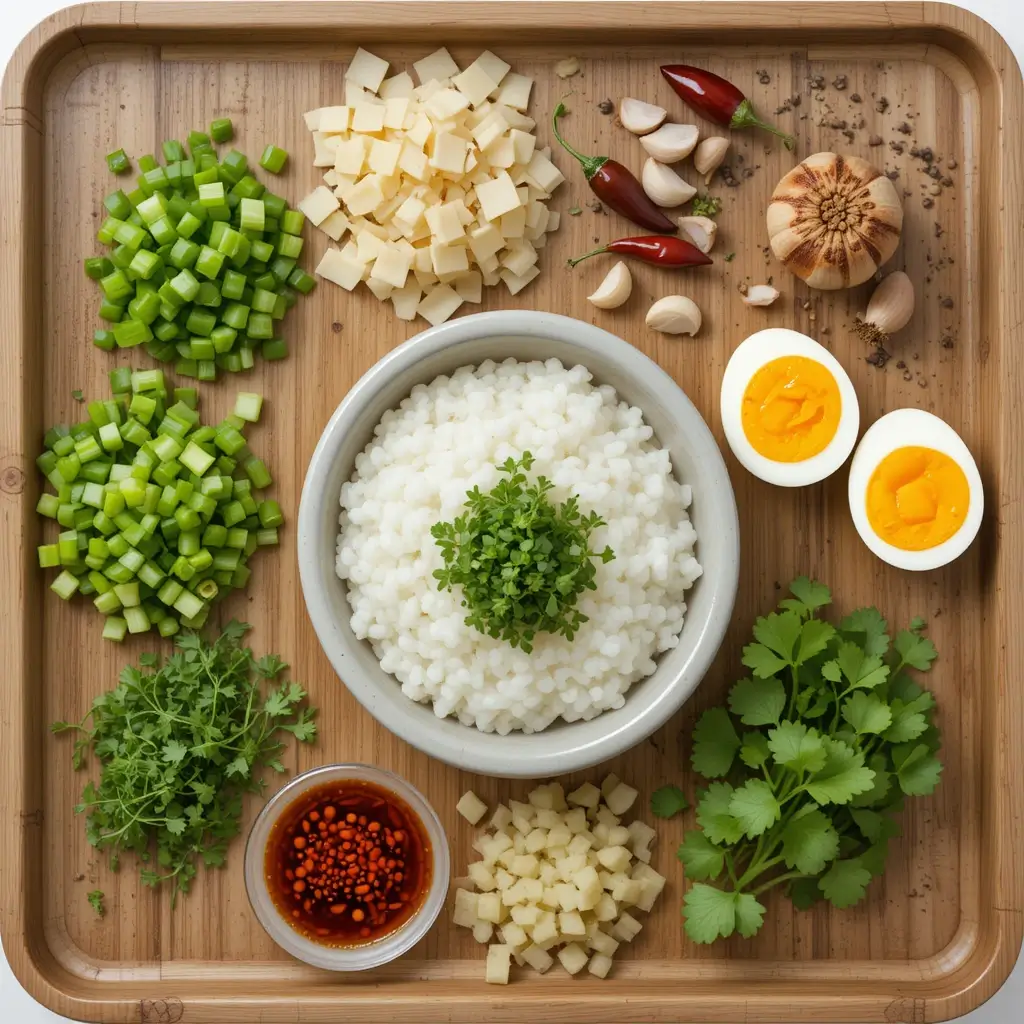
Step-by-Step Instructions for Making Rice Porridge
1: Rinse the Rice
Divide 1 cup of jasmine rice into a bowl then wash the rice grains with cold water until you observe the water remain clear. Cold rinsing removes starch excess so the porridge stays from turning into a sticky consistency.
Pro Tip: For a creamier texture, soak the rice in water for 30 minutes before cooking.
2: Cook the Rice
- A large pot requires medium heat to warm up 1 tablespoon of neutral oil for cooking.
- Add the rinsed rice and stir for 1-2 minutes to lightly toast it. This enhances the nutty flavor of the rice.
- Pour in 6 cups of water (or broth) and add 1 teaspoon of salt.
- Bring the mixture to a boil, then reduce the heat to low.
3: Simmer to Perfection
- Let the rice simmer uncovered for 45-50 minutes, stirring occasionally to prevent sticking.
- As the rice cooks, it will break down and thicken into a creamy porridge consistency.
- If the porridge becomes too thick, add more water or broth, ½ cup at a time, until you reach your desired consistency.
4: Add Your Toppings
Once the rice porridge is ready, it’s time to get creative with toppings! Here are some ideas:
- Savory: Add shredded chicken, fried garlic, and a drizzle of soy sauce.
- Spicy: Top with chili oil, sliced jalapeños, and a soft-boiled egg.
- Fresh: Garnish with chopped green onions, cilantro, and a squeeze of lime.
5: Serve and Enjoy
Ladle the hot rice porridge into bowls and top with your favorite ingredients. Serve immediately and enjoy the comforting flavors!
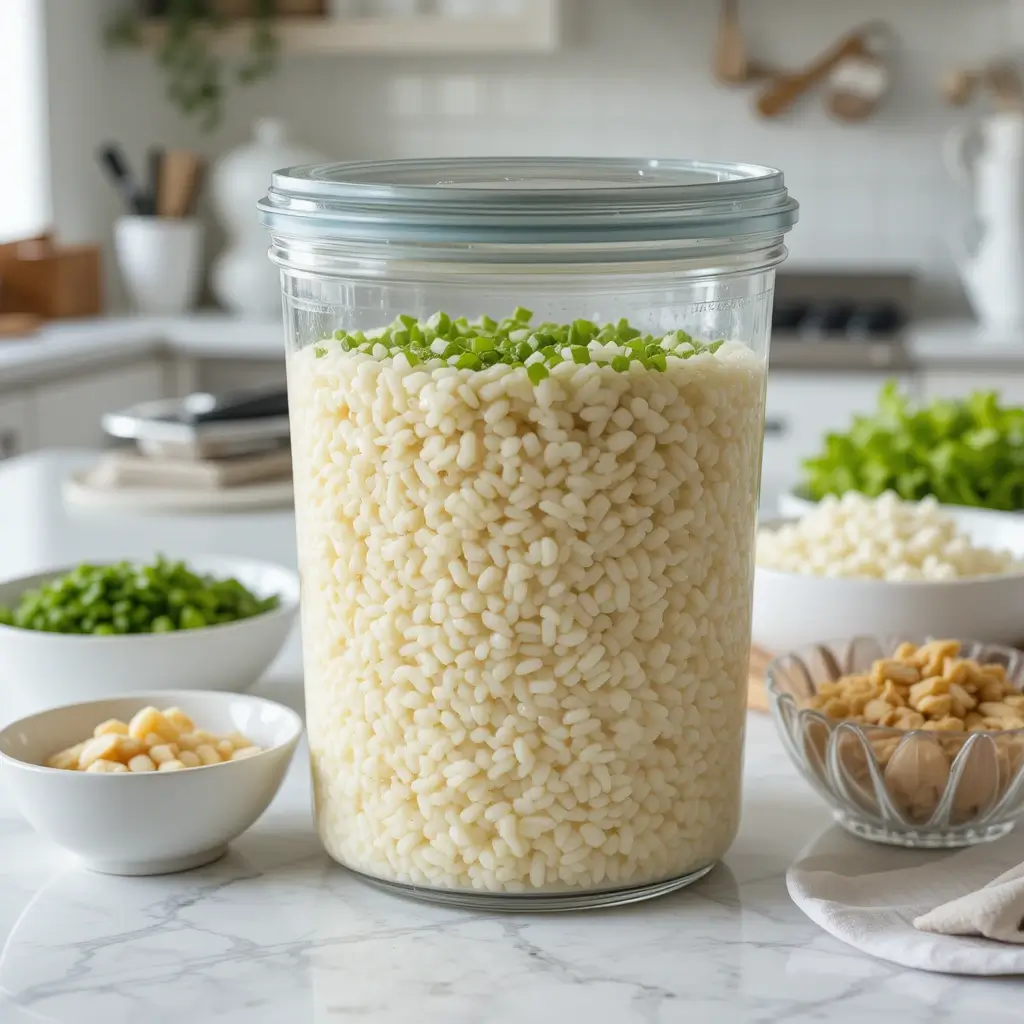
Helpful Tips and Variations
ce porridge is a forgiving and flexible dish, but a few expert tips and creative variations can take your recipe to the next level. Whether you’re a beginner or a seasoned cook, these suggestions will help you customize your porridge and make it truly unforgettable.
Helpful Tips for Making Rice Porridge
- Rinse the Rice Thoroughly
- A proper rice preparation begins with rinsing the rice pieces under cold water until clear water appears. Cold water rinsing clears excess starch which stops the porridge from becoming excessively sticky.
- Toast the Rice for Extra Flavor
- Lightly toasting the rice in oil before adding liquid enhances its nutty flavor and adds depth to the dish.
- Use Broth for Richer Flavor
- Swap water for chicken, vegetable, or bone broth to infuse your porridge with savory goodness.
- Soak the Rice for a Creamier Texture
- Soaking the rice for 30 minutes before cooking helps it break down more easily, resulting in a creamier porridge.
- Stir Occasionally
- Stirring the porridge every 10-15 minutes prevents the rice from sticking to the bottom of the pot and ensures even cooking.
- Adjust the Consistency
- If the porridge becomes too thick, add more water or broth, ½ cup at a time, until you reach your desired texture.
- Cook Low and Slow
- Simmering the rice over low heat allows it to break down gradually, creating a smooth and creamy consistency.
- Add Toppings Just Before Serving
- To preserve their texture and flavor, add toppings like fresh herbs, crunchy garnishes, or proteins right before serving.
- Meal Prep-Friendly
- Rice porridge stores well in the fridge for up to 4 days. Reheat it on the stovetop or in the microwave, adding a splash of water or broth to restore its creamy texture.
- Experiment with Spices
- Add spices like ginger, garlic, or star anise while cooking for an aromatic twist.
Creative Variations to Try
Rice porridge is a blank canvas for culinary creativity. The following section shares several tasty alternatives for sweet potato-based dishes:
1. Savory Rice Porridge
- Chinese Congee: Top with shredded chicken, fried garlic, green onions, and a drizzle of soy sauce.
- Filipino Arroz Caldo: Add ginger, garlic, and turmeric for a golden hue, then top with hard-boiled eggs and crispy fried garlic.
- Japanese Okayu: Keep it simple with just rice, water, and a pinch of salt, garnished with umeboshi (pickled plum) and sesame seeds.
2. Spicy Rice Porridge
- Thai-Inspired: Add chili oil, sliced jalapeños, and a squeeze of lime for a tangy, spicy kick.
- Korean Dakjuk: Use chicken broth, shredded chicken, and a dollop of gochujang (Korean chili paste) for a fiery twist.
3. Vegan and Vegetarian Options
- Tofu and Mushroom Porridge: Sauté mushrooms and tofu with garlic, then add them to the porridge for a hearty, plant-based meal.
- Coconut Milk Porridge: Replace half the water with coconut milk for a creamy, tropical flavor. Top with fresh herbs and roasted peanuts.
4. Sweet Rice Porridge
- Dessert-Style Porridge: Cook the rice with coconut milk and a touch of honey or sugar. Top with fresh fruit, nuts, and a sprinkle of cinnamon.
- Chinese Sweet Red Bean Porridge: Add sweetened red bean paste and serve warm for a traditional dessert.
5. Protein-Packed Porridge
- Egg Drop Porridge: Stir in beaten eggs during the last few minutes of cooking for a silky, protein-rich porridge.
- Seafood Porridge: Add cooked shrimp, fish, or scallops for a luxurious, ocean-inspired dish.
6. Global Flavors
- Indian Kanji: Add mustard seeds, curry leaves, and turmeric for a South Indian twist.
- Middle Eastern Harissa Porridge: Stir in harissa paste and top with roasted chickpeas and fresh herbs.
Substitution Ideas
- Rice Alternatives: Use quinoa, millet, or barley for a different grain base.
- Liquid Substitutes: Replace water with coconut water, almond milk, or even miso broth for unique flavors.
- Topping Swaps: Use what you have on hand! Leftover roasted veggies, grilled meats, or even a handful of nuts can make great toppings.
Why These Tips and Variations Work
These tips and variations ensure that your rice porridge is never boring. By experimenting with different flavors, textures, and ingredients, you can create a dish that suits your mood, dietary needs, and cultural preferences. Plus, they make the recipe accessible to everyone, from busy parents to adventurous foodies.
Related Recipes to Explore
If you enjoyed this rice porridge recipe, check out these other comforting dishes on my blog:
With these tips and variations, you’re ready to master the art of rice porridge and make it your own. Don’t be afraid to get creative—every bowl is an opportunity to explore new flavors and techniques. Happy cooking!
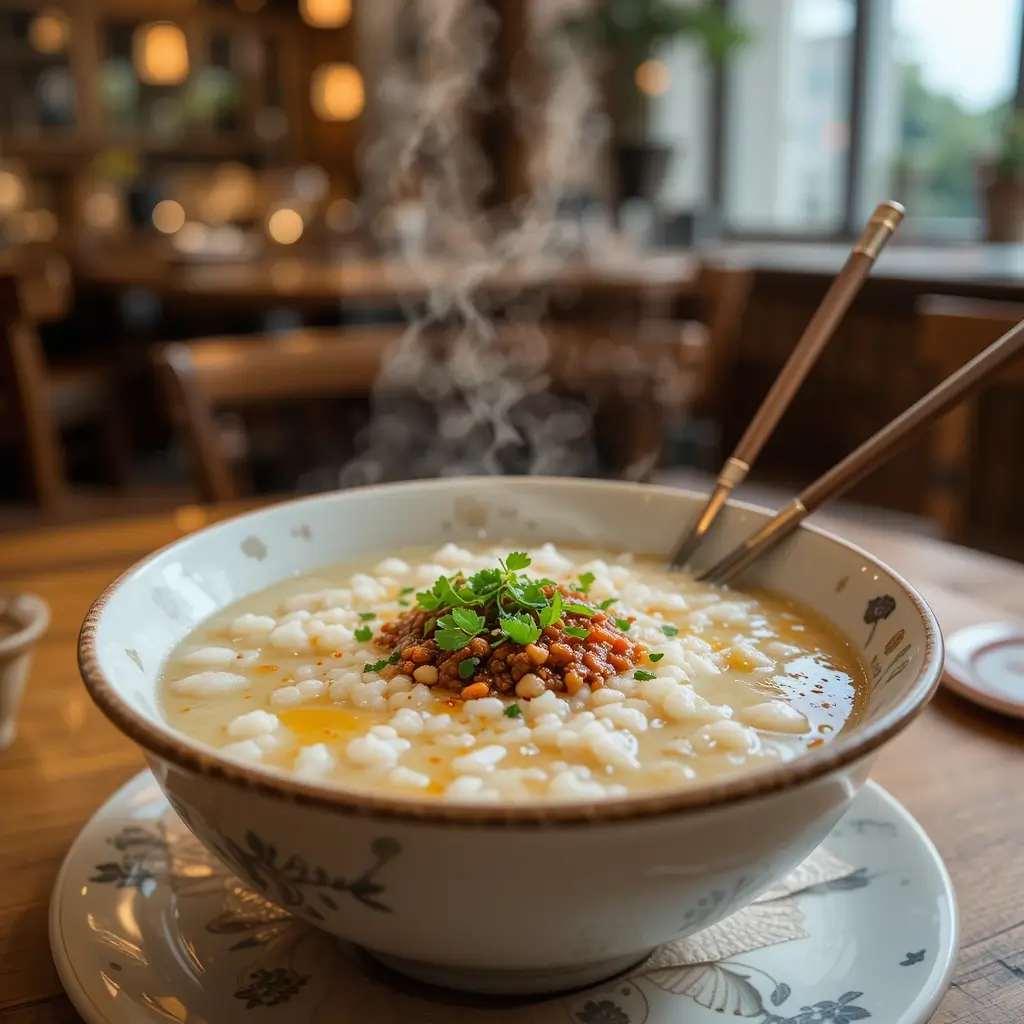
The History of Rice Porridge: A Timeless Global Dish
Rice porridge, known by many names such as congee, jook, okayu, or arroz caldo, is a dish that has transcended time, borders, and cultures. Its humble beginnings and universal appeal make it a fascinating subject for food lovers and history enthusiasts alike. Let’s take a journey through the rich history of this comforting dish and explore how it has become a staple in kitchens around the world.
Ancient Origins: A Dish Born of Necessity
Rice porridge’s origins can be traced back thousands of years to ancient China, where it was first documented during the Zhou Dynasty (1046–256 BCE). Known as zhou or congee, it was initially a simple mixture of rice and water, cooked until soft and creamy.
- Practical Beginnings: Rice porridge was born out of necessity. It was an economical way to stretch small amounts of rice to feed large families or communities.
- Medicinal Use: In traditional Chinese medicine, congee was often prescribed as a healing food for the sick or elderly due to its easy digestibility and nourishing properties.
Spread Across Asia: A Culinary Staple
From China, rice porridge spread across Asia, adapting to local tastes and ingredients. Each region developed its own unique version, reflecting its culinary traditions and cultural identity.
- Japan: In Japan, rice porridge is called okayu. It is often served plain or with simple toppings like pickled plums (umeboshi) or sesame seeds. It’s a common dish for those feeling unwell, much like chicken soup in Western cultures.
- Korea: Known as juk, Korean rice porridge is often enriched with ingredients like pumpkin, abalone, or pine nuts. It’s a popular comfort food and a common weaning food for babies.
- India: In South India, rice porridge is called kanji and is often flavored with mustard seeds, curry leaves, and turmeric. It’s a staple in many households, especially during monsoon season.
- Southeast Asia: In countries like Thailand, Vietnam, and the Philippines, rice porridge is a beloved street food. Thai khao tom, Vietnamese cháo, and Filipino arroz caldo are often served with flavorful toppings like ginger, garlic, and herbs.
Cultural Significance: More Than Just Food
Rice porridge is more than just a meal—it holds cultural and symbolic significance in many societies.
- Comfort and Healing: Across cultures, rice porridge is associated with comfort and healing. Its gentle texture and mild flavor make it ideal for those recovering from illness or in need of a soothing meal.
- Celebrations and Rituals: In some cultures, rice porridge is part of traditional celebrations. For example, in China, congee is often eaten during the Laba Festival, a Buddhist holiday celebrated in winter.
- Symbol of Humility: Rice porridge’s simplicity has made it a symbol of humility and frugality. It’s a reminder of the importance of resourcefulness and gratitude.
Global Adaptations: A Dish for the World
As people migrated and cultures intermingled, rice porridge traveled beyond Asia and found a place in global cuisine.
- European Influence: In Portugal, canja de galinha (chicken rice porridge) is a popular dish, influenced by Asian congee through historical trade routes.
- African Variations: In parts of Africa, rice porridge is often made with local grains like millet or sorghum, showcasing the dish’s adaptability.
- Modern Fusion: Today, chefs and home cooks around the world are reinventing rice porridge with modern twists, such as adding truffle oil, avocado, or even kimchi.
Why Rice Porridge Endures
The enduring popularity of rice porridge can be attributed to its simplicity, versatility, and universal appeal.
- Accessibility: Rice and water are affordable and accessible ingredients, making rice porridge a dish for everyone, regardless of socioeconomic status.
- Adaptability: Its neutral flavor profile allows it to be customized with endless toppings and flavors, making it a canvas for culinary creativity.
- Timelessness: Despite its ancient origins, rice porridge remains relevant in modern kitchens, proving that some dishes truly stand the test of time.
A Dish That Connects Us All
Rice porridge is more than just a recipe—it’s a story of resilience, adaptation, and shared humanity. Whether you’re enjoying a bowl of Chinese congee, Japanese okayu, or Filipino arroz caldo, you’re part of a global tradition that has nourished generations.
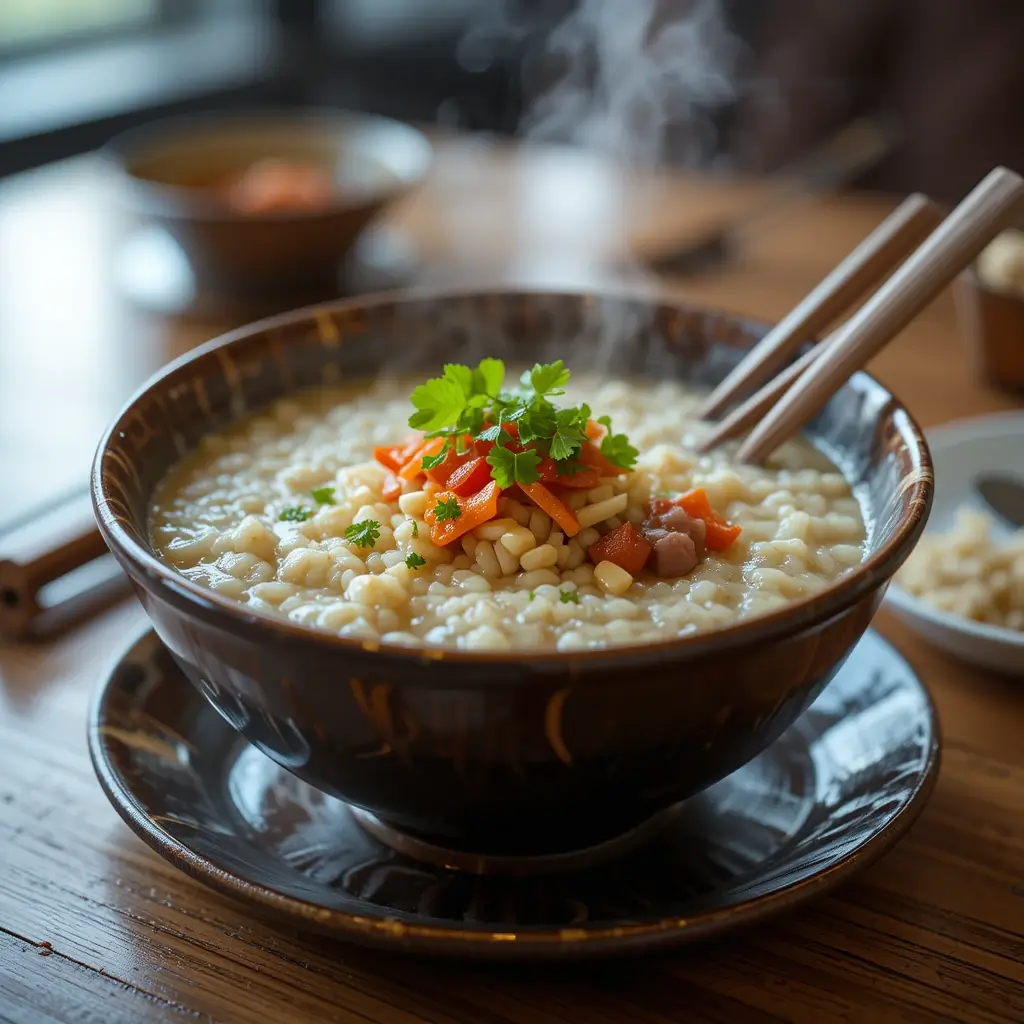
Why You’ll Love This Rice Porridge Recipe
Rice porridge is more than just a simple dish—it’s a comforting, versatile, and nourishing meal that has won the hearts of food lovers worldwide. Here’s why this rice porridge recipe will become a staple in your kitchen:
1. Comfort in Every Bite
There’s something incredibly soothing about a warm bowl of rice porridge. Its creamy texture and mild flavor make it the ultimate comfort food, perfect for cozy lunches, rainy days, or when you’re feeling under the weather.
2. Endlessly Customizable
One of the best things about rice porridge is its versatility. Whether you prefer savory or sweet, light or hearty, this recipe can be tailored to your taste. Add your favorite proteins, veggies, or spices to make it uniquely yours.
3. Easy to Make
With just a handful of ingredients and minimal effort, this rice porridge recipe is beginner-friendly and stress-free. It’s a one-pot wonder that requires little attention, making it ideal for busy weekdays or lazy weekends.
4. Globally Inspired
Rice porridge is a dish that transcends borders. From Chinese congee to Filipino arroz caldo, this recipe celebrates the global love for this humble dish. It’s a delicious way to explore different cultures and flavors from the comfort of your home.
5. Healthy and Nourishing
Packed with simple, wholesome ingredients, rice porridge is easy on the stomach and highly digestible. It’s a great option for those looking for a light yet satisfying meal. Plus, you can boost its nutritional value by adding protein-rich toppings or fresh veggies.
6. Perfect for Meal Prep
Rice porridge is a fantastic make-ahead meal. Cook a big batch, store it in the fridge, and reheat it throughout the week. It’s a time-saving solution for busy individuals who still want to enjoy a homemade meal.
7. Kid-Friendly and Family-Approved
Its mild flavor and soft texture make rice porridge a hit with kids and picky eaters. You can sneak in nutritious toppings or keep it simple—either way, it’s a crowd-pleaser.
8. Budget-Friendly
This recipe is incredibly economical, using pantry staples like rice and water. You don’t need expensive ingredients to create a delicious and satisfying meal.
9. Adaptable for Dietary Needs
Whether you’re gluten-free, vegan, or following a low-sodium diet, this rice porridge recipe can be easily adjusted to meet your dietary requirements. It’s a dish that truly works for everyone.
10. A Blank Canvas for Creativity
Rice porridge is like a blank canvas waiting for your culinary artistry. Experiment with different broths, spices, and toppings to create a dish that reflects your personal taste and creativity.
In short, this rice porridge recipe is a must-try for anyone who loves food that’s comforting, customizable, and deeply satisfying. Whether you’re a seasoned cook or a kitchen novice, this dish will quickly become a favorite in your recipe collection. So, grab your ingredients and get ready to fall in love with the magic of rice porridge!
FAQs
Rice porridge, also called congee or jook, is a creamy dish made by simmering rice in water or broth until soft and thick. It’s a comforting meal popular in many cultures.
Short-grain or medium-grain rice (like jasmine or sushi rice) works best for a creamy texture, but long-grain or leftover rice can also be used.
Use more liquid (1:8 rice-to-water ratio), soak the rice before cooking, and stir occasionally while simmering.
Yes! Cook on high pressure for 20-25 minutes, then let the pressure release naturally for creamy results.
Popular options include shredded chicken, fried garlic, green onions, soy sauce, soft-boiled eggs, chili oil, or fresh herbs. For sweet versions, try coconut milk, honey, or fruit.
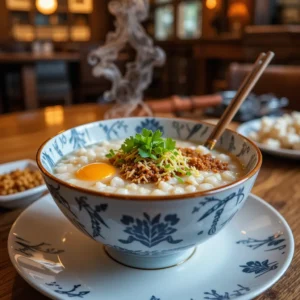
Comfort in a Bowl: Easy Rice Porridge Recipe for Cozy Lunches
Equipment
- Large pot or Dutch oven
- Wooden spoon or spatula
- Measuring Cups and Spoons
- Colander (for rinsing rice)
Ingredients
- 1 cup Jasmine rice (or short-grain rice)
- 6 cups Water (or broth for extra flavor)
- 1 tsp Salt
- 1 tbsp Neutral oil (e.g., vegetable or avocado oil)
Optional toppings
- Green onions, fried garlic, soy sauce, soft-boiled eggs, shredded chicken, fresh herbs, chili oil, or sesame oil
Instructions
- Rinse the Rice: Rinse 1 cup rice under cold water until the water runs clear.

- Toast the Rice: Heat 1 tbsp oil in a pot, add rice, and toast for 1-2 minutes.

- Cook the Rice: Add 6 cups water and 1 tsp salt. Bring to a boil, then simmer for 45-50 minutes, stirring occasionally.

- Adjust Consistency: Add more water if the porridge is too thick.

- Add Toppings: Serve hot with your favorite toppings like green onions, fried garlic, or soft-boiled eggs.

- Serve and Enjoy

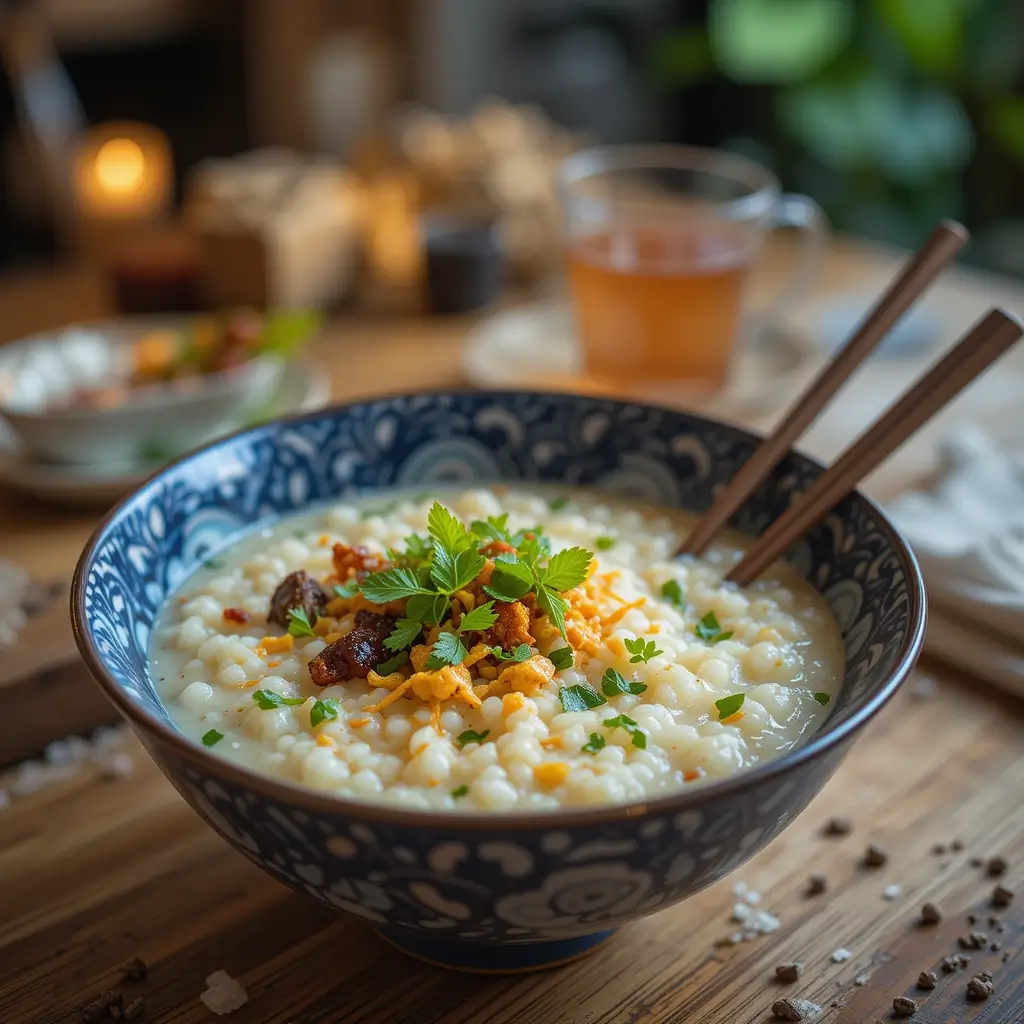
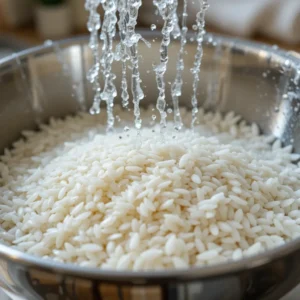
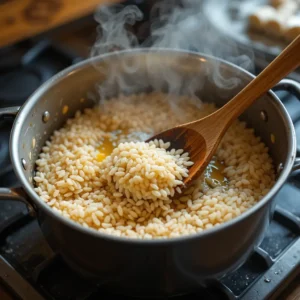
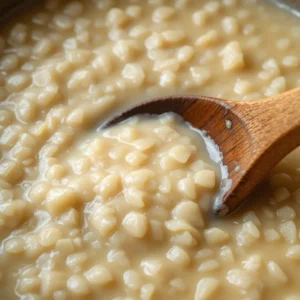
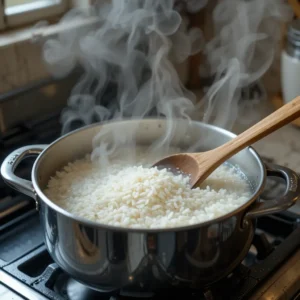
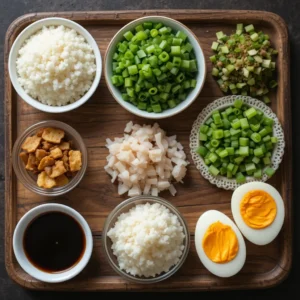
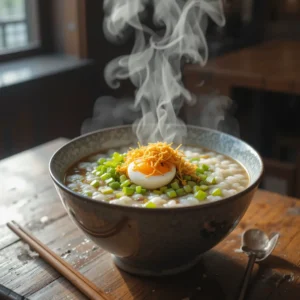
Delicious and easy to make 👍
J’aime bien cette recette
Merci